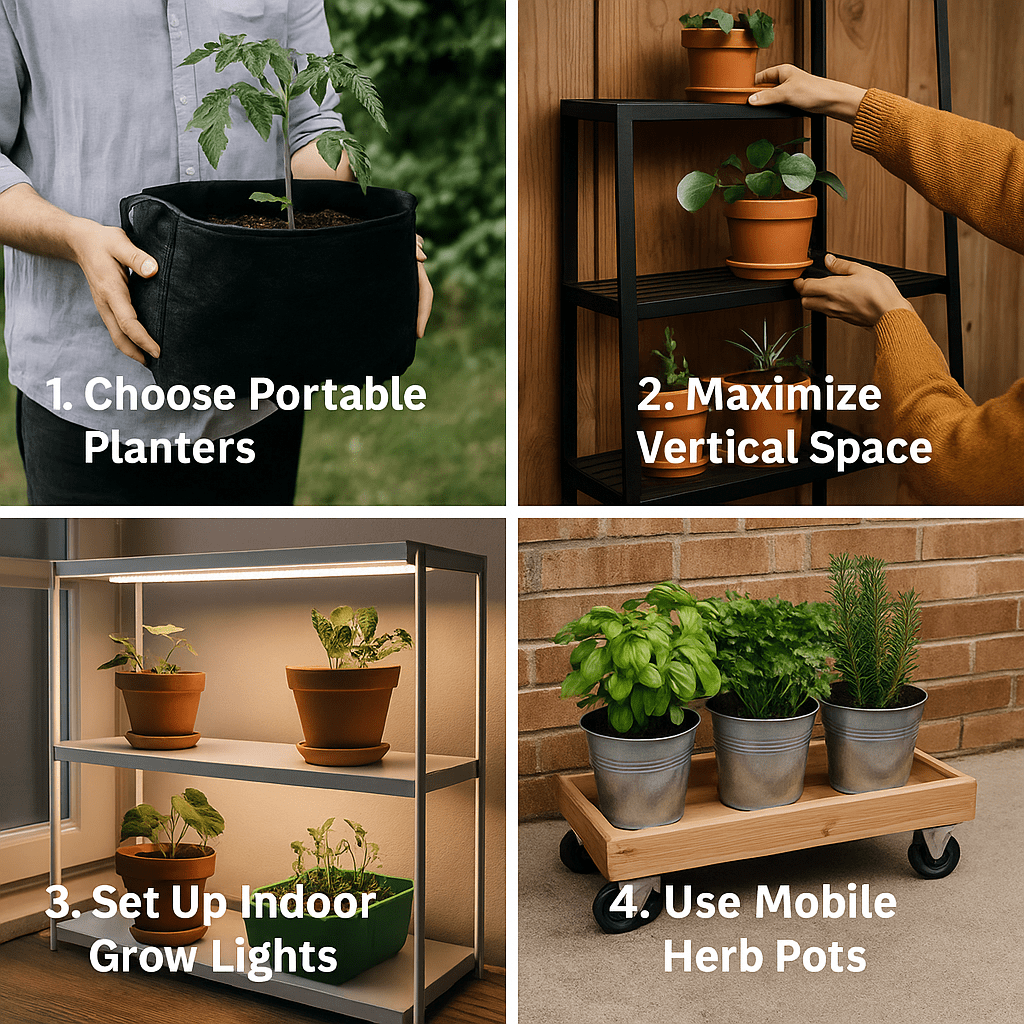Urban gardening for renters is a smart, flexible way to enjoy the benefits of greenery without needing permanent outdoor space. Whether you live in a small apartment, a shared flat, or a rental home with strict rules, there are many creative and portable ways to grow plants and enjoy nature right where you are. This guide offers actionable strategies and design ideas to help renters build a productive garden without risking their deposit or altering the property.
Why Urban Gardening Matters for Renters
Urban renters often face limitations that homeowners don’t. Lack of land, restrictive lease agreements, and limited sunlight can all make traditional gardening feel out of reach. However, with portable solutions and a bit of creativity, gardening can become part of your lifestyle, no matter your square footage.
Benefits of Urban Gardening in a Rental Space
- Improves air quality: Houseplants and herbs filter indoor air naturally.
- Boosts mood and mental health: Greenery helps reduce stress and fosters a sense of accomplishment.
- Provides fresh food: Grow your own herbs, lettuce, or tomatoes—even on a balcony.
- Customizes your space: Plants bring personality, beauty, and vibrancy to indoor and outdoor areas.
Getting Started: Assess Your Space and Light
Before purchasing pots or soil, evaluate your available space and light exposure.
Questions to Ask:
- Do you have a balcony, windowsill, or shared rooftop?
- How many hours of sunlight does the space receive?
- Will your containers need to be moved often?
- Are there property restrictions on hanging baskets or railing planters?
Understanding your limitations will help you choose the right plants and systems from the start.
Best Portable Gardening Solutions for Renters
1. Container Gardening
Container gardening is the most renter-friendly method. You can use pots, buckets, or bins to grow herbs, flowers, and even vegetables.
Tips:
- Choose lightweight containers for easy movement.
- Add drainage holes to avoid root rot.
- Use a high-quality potting mix to support plant health.
2. Vertical Gardening
Maximize limited space with vertical arrangements. Ideal for balconies or indoor walls, this method is both stylish and space-efficient.
Ideas:
- Install tension rod shelves between balcony railings.
- Hang planters using over-the-door hooks or adhesive strips.
- Use recycled wooden pallets to create a vertical herb garden.
3. Hanging Baskets and Rail Planters
Hanging solutions are great for flowers or cascading herbs like thyme or oregano.
Important: Always check with your landlord before installing hooks or drilling holes. You can also use removable adhesive ceiling hooks or hanging frames to avoid permanent changes.
4. Rolling Garden Carts
These portable planters on wheels are perfect for balconies or patios. Move them indoors during bad weather or relocate them to chase the sun.
5. Indoor Grow Stations
If outdoor space is nonexistent, invest in a small grow light and grow tent. You can raise greens, microgreens, or herbs right inside your kitchen or bedroom.
Choosing the Right Plants for Urban Rentals
Pick plants that suit your environment and lifestyle.
Low-Maintenance Indoor Plants:
- Snake plant
- Spider plant
- Pothos
- Peace lily
Edibles for Small Spaces:
- Basil, cilantro, mint
- Cherry tomatoes
- Lettuce and arugula
- Strawberries (in hanging pots)
Flowers That Thrive in Containers:
- Marigolds
- Petunias
- Begonias
- Geraniums
Step-by-Step: Setting Up a Portable Urban Garden
Step 1: Plan Your Layout
Sketch a rough design of your available space. Decide where each plant type will go based on sunlight and accessibility.
Step 2: Select Your Containers
Opt for matching or recycled containers to keep the look cohesive. Make sure each has proper drainage.
Step 3: Prepare the Soil
Use potting mix suitable for containers. For edibles, consider a mix with compost and slow-release nutrients.
Step 4: Plant Thoughtfully
Follow spacing instructions on seed packets or plant labels. Avoid overcrowding to promote airflow and reduce disease.
Step 5: Water and Monitor
Water consistently but avoid soggy soil. Use a moisture meter or the finger test to check soil dampness.
Step 6: Adjust as Needed
Rotate plants for balanced sun exposure. Move containers around if needed for better access or lighting.

Maintenance Tips for Renters
- Use saucers to prevent water damage indoors.
- Place mats or trays under containers on balconies to protect surfaces.
- Prune regularly to encourage growth and minimize mess.
- Keep fertilizer and tools in a portable bin for easy storage.
Creative DIY Projects to Try
Repurposed Shoe Organizer Herb Garden
Hang a fabric shoe organizer on a railing or wall. Fill each pocket with soil and herbs like parsley, chives, or mint.
Upcycled Drawer Planters
Old drawers from discarded furniture can serve as rustic planting beds for small flowers or leafy greens.
Magnetic Mini Pots
Attach small metal containers to your fridge or filing cabinet to grow tiny succulents or air plants.
Conclusion: Grow Freely, Wherever You Live
Urban gardening for renters is about working with what you have—not waiting for the perfect plot of land. With flexible containers, smart plant choices, and a dash of creativity, you can enjoy fresh herbs, flowers, and greenery even in the heart of the city. Start small, adapt as needed, and let your plants thrive alongside your urban lifestyle.
Save this guide for your next planting weekend—or share it with a friend who rents and dreams of gardening!
FAQ: Urban Gardening for Renters
Q1: Can I grow vegetables indoors in a rental apartment?
Yes, many vegetables like lettuce, microgreens, and cherry tomatoes can thrive indoors with adequate light or grow lamps.
Q2: How can I garden without damaging walls or surfaces?
Use removable adhesive hooks, tension rods, or over-the-door organizers. Place protective mats under pots to prevent staining.
Q3: What’s the easiest edible plant for beginners?
Herbs like basil, mint, and chives are excellent starter plants that grow quickly and require minimal effort.
Need planters, potting mix, or grow lights? Find renter-friendly gardening supplies on Gardener’s Supply Company.
If you’re starting from scratch, don’t miss our guide on starting seeds indoors.
Written by Kate Smith | Plant Care Enthusiast & Urban Gardener
